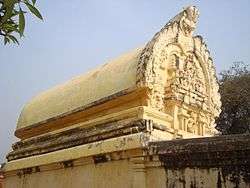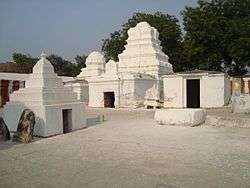Chejarla
| Chejarla Cherumjarla, Chejerla | |
|---|---|
| historical village | |
 Chejarla Kapoteswara temple | |
 Chejarla Location in Andhra Pradesh, India  Chejarla Chejarla (India) | |
| Coordinates: 16°18′59″N 79°50′58″E / 16.31639°N 79.84944°ECoordinates: 16°18′59″N 79°50′58″E / 16.31639°N 79.84944°E | |
| Country |
|
| State | Andhra Pradesh |
| District | Guntur District |
| Languages | |
| • Official | Telugu |
| Time zone | UTC+5:30 (IST) |
| Vehicle registration | AP 7 |
| Nearest city | Guntur |
Chejarla (also Cezarla or Chejerla[1]) is a village situated at a distance of 15 miles (24 km) west of Narasaraopet in Nekarikallu Mandal of Guntur District, Andhra Pradesh. There is a good metalled road for a part of the way and for the rest one can reach the village only by Jeep or by bus. From Narasaraopet every hour one bus is available. Nearest railway station is Narasarao pet.
History
The village stands in the plains and is surrounded by a rocky hills and is covered by scrub jungle. The temple here is dedicated to Lord Siva and dates to the 4th or 5th century AD.[2] The deity is called Kapotheswara.[3]
Buddhism
This story is a renowned one not only, in Hindu mythology, but also in the Buddhist Jataka tales, which give us the lives of Siddhartha, the Buddha, in his previous Janmas.
The Sibi Jataka is as hoary and sacred to the Buddhist, as an embodiment of 'Saranagata vatsala', as Sibi Chakravarti is to the Hindu, as a supreme symbol of 'Raja Dharma' which enjoins a king to protect the refugee even at the cost of his own life. It was a Buddhist Monastery later converted to an Hindu Shrine as per Historical evidences found.[4]
Hinduism

This is probably the only temple in the whole of India dedicated to Lord Siva as Kapotheswara. The deity is in Lingakara. Siva is here represented as Kapotheswara, who gave a portion of his own body in order to save a pigeon that took refuge with him.Curiously, in the imago of the Linga there are even today large cavities as if portions have been scooped or cut out, and these are said to be the places of the body, from which the Lord cut off his own flesh, in order to save the life of the Kapotha.
The image is said to be the image of the 'Kalebara' of Sibi, with the head cut off, and on top of the Linga, there are still two large vertical cavities. One of these cavities helps to drain off the Abhisheka Tirtha to an unknown place and even today the smell of raw flesh and blood comes out of this since the God here is a very powerful one. The temple is of the greatest importance to us from the point of view of temple architecture. There are, as is well known, three types of temple architecture.
Apsidal Temple
The temple of Chezerla is a rare exception and this is a temple on the Apsidal model. This Apsidal plan and barrel vaulted structure, is classified in the VastuSastras, as 'Hasti prasta' or elephant back. These were originally Buddhist Chaityas and were readjusted for the purpose of Hindu worship, by the introduction of internal walls and upper store to seclude the Garbha Griha from the rest of the building. The end of the temple takes the form of an apse and in its centre is a white marble Linga.
The fact that the temple is sacred to Buddhism and Hinduism and is built in a unique style, the temple must have come into existence, at a period of mutual tolerance between Hinduism and Buddhism. A famous inscription[5] in the temple further supports this.
A similar temple is the Trivikrama Temple at Ter, Maharashtra.[6]
Map
Refer wikimapia link for the above described geographies:http://wikimapia.org/#lat=16.316433&lon=79.8496476&z=19&l=0&m=b
References
- ↑ there is another Chejerla in Nellore District
- ↑ Reddy, Krishna, Indian History Tata McGraw-Hill, 2006.
- ↑ "Guntur Culture | Guntur History". World66.com. 2007-02-27. Retrieved 2016-01-16.
- ↑ "Select Andhra Temples : Dr.M.R.Rao : Free Download & Streaming : Internet Archive". Archive.org. Retrieved 2016-01-16.
- ↑ whatisindia.com (2007-03-06). "South Indian Inscriptions Volume_16 - Telugu Inscriptions of the Vijayanagara Dynasty @". Whatisindia.com. Retrieved 2016-01-16.
- ↑ Ahir, D. C. (1992). Buddhism in South India. South Asia Books. p. 72. ISBN 9788170303329.
- This article is based on this World66 article, which is licensed under a Creative Commons license.

